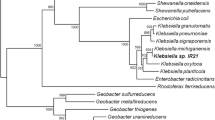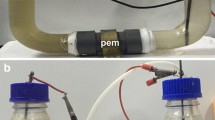Abstract
Microbial fuel cell is a renewable and sustainable technology for simultaneous oxidation of organic matter and electricity generation. The present study utilizes sequential optimization strategy of media components for voltage enhancement in microbial fuel cell exercising Klebsiella pneumoniae, a fermentative bacterium for the bioelectricity generation. Taguchi model screened the significant factors that are KH2PO4, glucose and asparagine which significantly influences the voltage generation. A second-order polynomial equation was created to correlate the relationship between independent variables and open-circuit voltage yield. These factors were further optimized using central composite design of response surface methodology and the optimal concentration for KH2PO4, glucose and asparagine were found to be 0.33172, 28.91 and 5.3750 g/l, respectively. Under optimal media components, voltage yield of 985mV (highest reported till date) was observed showing an increment of 16.844% with respect to un-optimized media. Statistical optimization and Klebsiella pneumoniae together has been employed for the first time in microbial fuel cell.
Similar content being viewed by others
References
Logan B.E.: Exoelectrogenic bacteria that power microbial fuel cells. Nat. Rev. Microbiol. 7, 375–381 (2009)
Lovley, D.R.; Nevin, K.P.: A shift in the current: new applications and concepts for microbe-electrode electron exchange. Curr. Opin. Biotechnol. (2011). doi:10.1016/j.copbio.2011.01.009
Hegde, S.; Bhadri, G.; Narsapur, K.; Koppal, S.; Oswal, P. et al.: Statistical optimization of medium components by response surface methodology for enhanced production of bacterial cellulose by Gluconacetobacter persimmonis. J. Bioprocess. Biotech. (2013). doi:10.4172/2155-9821.1000142
Rao M.S., Munoz J., Stevens W.F.: Critical factors in chitin production by fermentation of shrimp biowaste. Appl. Microbiol. Biotechnol. 54, 808–813 (2000)
Adour L., Arbia W., Amrane A., Mameri N.: Combined use of waste materials-recovery of chitin from shrimp shells by lactic acid fermentation supplemented with date juice waste or glucose. J. Chem. Technol. Biotechnol. 83, 1664–1669 (2008)
Qiu P., Cui M., Kang K., Park B., Son Y., Khim E., Jang M., Khim J.: Application of Box–Behnken design with response surface methodology for modeling and optimizing ultrasonic oxidation of arsenite with H2O2. Cent. Eur. J. Chem. 12(2), 164–172 (2014)
Aranganathan, V.; Kanimozhi, A.M.; Palvannan, T.: Statistical optimization of synthetic azo dye (orange II) degradation by azoreductase from Pseudomonas oleovorans PAMD_1. Prep. Biochem. Biotechnol. 43(7), 649–67 (2013)
Swanson T.R., Carroll J.O., Britto R.A., Duhart D.J.: Development and field confirmation of a mathematical model for amyloglucosidase/pullulanase saccharification. Starch-Stärke 38, 382–387 (1986)
Strobel R.J., Nakatsukasa W.M.: Response surface methods for optimizing Saccharopolyspora spinosa, a novel macrolide producer. J. Ind. Microbiol. 11(2), 121–127 (1993)
Park Y.S., Kang S.W., Lee J.S., Hong S.I., Kim S.W.: Xylanase production in solid state fermentation by Aspergillus niger mutant using statistical experimental designs. Appl. Microbiol. Biotechnol. 58(6), 761–766 (2002)
Yuvraj C., Aranganathan V.: Isolation and identification of prospective dissimilatory iron reducing bacteria for electricity generation in microbial fuel cell. IJALS 8(3), 300–306 (2015)
Kumar S., Kumar H.D., Babu K.G.: A study on the electricity generation from the cow dung using microbial fuel cell. J. Biochem. Tech. 3(4), 442–447 (2012)
Venkata Mohan S., Saravanan R., Raghavulu S.V., Mohanakrishna G., Sarma P.N.: Bioelectricity production from wastewater treatment in dual chambered microbial fuel cell (MFC) using selectively enriched mixed microflora: effect of catholyte. Bioresource. Technol. 99, 596–603 (2008)
Athreya S., Venkatesh Y.D.: Application of Taguchi method for optimization of process parameters in improving the surface roughness of lathe facing operation. IRJES 1, 13–19 (2012)
Wen Q., Wu Y., Zhao L., Sun Q., Kong F.: Electricity generation and brewery wastewater treatment from sequential anode-cathode microbial fuel cell. JZUSB 11, 87–93 (2010)
Jang J.K., Pham T.H., Chang I.S., Kang K.H., Moon H., Cho K.S., Kim B.H.: Construction and operation of a novel mediator- and membrane-less microbial fuel cell. Process. Biochem. 39, 1007–1012 (2004)
Reddy L.V., Kumar S.P., Wee Y.J.: Microbial Fuel Cells (MFCs)-a novel source of energy for new millennium. Curr. Res. Technol. Educ. top. Appl. Microbiol. Microb. Biotechnol. 2, 956–964 (2010)
Sikora A., Wójtowicz-Sie K.J., Piela P., Zielenkiewicz U., Tomczyk-ak K., Chojnacka A., Sikora R., Kowalczyk P., Grzesiuk E.B., Baszczyk M.: Selection of Bacteria Capable of Dissimilatory Reduction of Fe(III) from a Long-term Continuous Culture on Molasses and Their Use in a Microbial Fuel Cell. J. Microbiol. Biotechnol. 21(3), 305–316 (2011)
Zhang, X.; Zhou, J.; Fu, W.; Li, Z.; Zhong, J.; Yang, J.; Xiao, L.; Tan, H. Response surface methodology used for statistical optimization of jiean peptide production by Bacillus subtilis. Electron. J. Biotecnol. (2010). doi:10.2225/vol13-issue4-fulltext-5
Ghoshal G., Kamble A., Shivhare U.S., Banerjee U.C.: Optimization of culture conditions for the production of xylanase in submerge fermentation by Penicillium citrinum using response surface methodology. IJRRAS 6(2), 132–137 (2011)
Tamakloe R.Y., Commey M., Nai A.O., Kwamena T.S., Singh K.: Effect of porosity on OCV and wastewater treatment efficiency of a clay partitioned ion-exchange double-chamber microbial fuel cell. Int. Adv. Res. Eng. Tech. 6(5), 06–11 (2015)
Oh S.E., Logan B.E.: Voltage reversal during microbial fuel cell stack operation. J. Power. Sources. 167, 11–17 (2007)
Author information
Authors and Affiliations
Corresponding author
Rights and permissions
About this article
Cite this article
Yuvraj, C., Aranganathan, V. Enhancement of Voltage Generation Using Isolated Dissimilatory Iron-Reducing (DIR) Bacteria Klebsiella pneumoniae in Microbial Fuel Cell. Arab J Sci Eng 42, 65–73 (2017). https://doi.org/10.1007/s13369-016-2108-4
Received:
Accepted:
Published:
Issue Date:
DOI: https://doi.org/10.1007/s13369-016-2108-4




